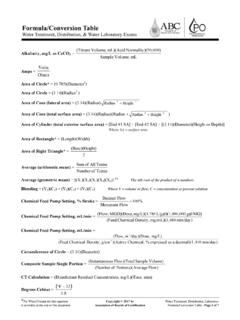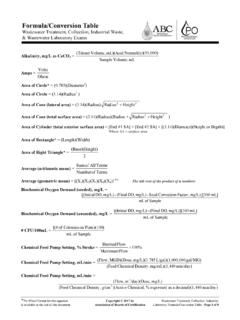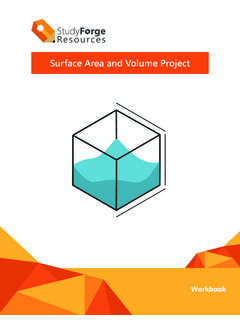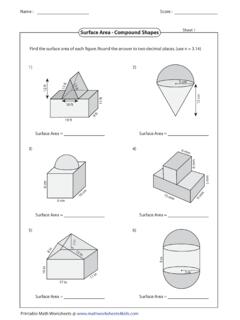Transcription of Chapter 12: Surface Area - MacHighway
1 Surface area Lesson 12-1 Identify three-dimensional figures. Key Vocabulary Lesson 12-2 Draw two-dimensional models polyhedron (p. 637). for solids. net (p. 644). Lessons 12-3 through 12-6 Find the lateral Surface area (p. 644). areas and Surface areas of prisms, cylinders, lateral area (p. 649). pyramids, and cones. Lesson 12-7 Find the Surface areas of spheres and hemispheres. Diamonds and other gems are cut to enhance the beauty of the stones. The stones are cut into regular geometric shapes. Each cut has a special name. You will learn more about gemology in Lesson 12-1. 634 Chapter 12 Surface area Richard T. Nowitz/Photo Researchers Prerequisite Skills To be successful in this Chapter , you'll need to master these skills and be able to apply them in problem-solving situations. Review these skills before beginning Chapter 12. For Lesson 12-1 Parallel Lines and Planes In the figure, . Determine whether each statement is true, AC. false, or cannot be determined. (For review, see Lesson 3-1.)
2 B K. 1. ADC lies in plane N . 2. ABC lies in plane K .. A C. B. 3. The line containing A is parallel to plane K . N D. C. 4. The line containing A lies in plane K . For Lessons 12-3 and 12-5 Areas of Triangles and Trapezoids Find the area of each figure. Round to the nearest tenth if necessary. (For review, see Lesson 11-2.). 5. 19 ft 6. 12 mm 7. 6 ft 13 mm m 35 mm 29 ft m For Lessons 12-4, 12-6, and 12-7 area of Circles Find the area of each circle with the given radius or diameter. Round to the nearest tenth. (For review, see Lesson 11-3.). 8. d cm 9. r yd 10. d m Surface area Make this Foldable to help you organize your notes. Begin with a sheet of 11" by 17" paper. Fold Lengthwise Fold Fold lengthwise leaving Fold the paper into a two-inch tab. five sections. Cut Label Open. Cut along each Label as shown. Surface area fold to make five tabs. ids ers s Sphere Pyram s Cylind Cones Prism Reading and Writing As you read and study the Chapter , define terms and write notes about Surface area for each three-dimensional figure.
3 Chapter 12 Surface area 635. Three-Dimensional Figures Virginia SOL Standard The student will make a model of a three-dimensional figure from a two-dimensional draw- ing and make a two-dimensional representation of a three-dimensional object. Models and representations will include scale drawings, perspective drawings, blueprints, or computer simulations. Use orthogonal drawings of three-dimensional figures to make models. Identify and use three-dimensional figures. are drawings of three- dimensional structures Vocabulary valuable to archaeologists? orthogonal drawing corner view Archaeologists and Egyptologists continue perspective view to study the Great Pyramids of Egypt. polyhedron Drawings of these three-dimensional face structures are helpful in their study. edges prism bases regular prism pyramid DRAWINGS OF THREE-DIMENSIONAL FIGURES If you see a three- regular polyhedron dimensional object from only one viewpoint, you may not know its true shape. Platonic solids Here are four views of the pyramid of cylinder Menkaure in Giza, Egypt.
4 The two- cone dimensional views of the top, left, front, sphere and right sides of an object are called an cross section orthogonal drawing . top view left view front view right view reflection symmetry This sculpture is Stacked Pyramid by Jackie Ferrara. How can we show the stacks of blocks on each side of the piece in a two- dimensional drawing? Let the edge of each block represent a unit of length and use a dark segment to indicate a break in the Surface . Study Tip The view of a figure from a corner is called the Corner View corner view or perspective view . You can use isometric left Drawings dot paper to draw the corner view of a solid figure. One Use models to help you corner view of a cube is shown at the right. visualize the corner view of a solid. front right Example 1 Use Orthogonal Drawings a. Draw the back view of a figure given its orthogonal drawing. Use blocks to make a model. Then use your model to draw the back view. The top view indicates two rows and top view left view front view right view two columns of different heights.
5 The front view indicates that the left side is 5 blocks high and the right side is 3 blocks high. The dark segments indicate breaks in the Surface . 636 Chapter 12 Surface area (t)Stephen Studd/Getty Images, (b)Collection Museum of Contemporary Art, Chicago, gift of Lannan Foundation. Photo by James Isberner The right view indicates that the right front column is only one block high. The left front column is 4 blocks high. The right back column is 3 blocks high. Check the left side of your model. All of the blocks should be flush. Check to see that all views correspond to the model. Now that your model is accurate, turn it around to the back and draw what you see. The blocks are flush, so no heavy segments are needed. b. Draw the corner view of the figure. Turn your model so you are looking at the corners of the blocks. The lowest columns should be in front so the differences in height between the columns is visible. Connect the dots on the isometric dot paper to represent the edges of the solid.
6 Shade the tops of each column. Study Tip Reading Math The plural version of a polyhedron is either polyhedrons or polyhedra. IDENTIFY THREE-DIMENSIONAL FIGURES A solid with all flat surfaces Both forms are correct. that enclose a single region of space is called a polyhedron. Each flat Surface , or face, is a polygon. The line segments where the faces intersect are called edges . Edges intersect at a point called a vertex. A prism is a polyhedron with two parallel congruent faces called bases . The other faces are parallelograms. The intersection of three edges is a vertex. Prisms are named by the shape of their bases. A regular prism is a prism with bases that are regular polygons. A cube is an example of a regular prism. Some common prisms are shown below. Name Triangular Prism Rectangular Prism Pentagonal Prism Model Shape of triangle rectangle pentagon Base A polyhedron with all faces (except for one) intersecting at one vertex is a pyramid . Pyramids are named for their bases, which can be any polygon.
7 A polyhedron is a regular polyhedron if all of its faces are square pyramid regular congruent polygons and all of the edges are congruent. Lesson 12-1 Three-Dimensional Figures 637. (t)Aaron Haupt, (b)Scala/Art Resource, NY. There are exactly five types of regular polyhedra. These are called the Platonic solids because Plato described them extensively in his writings. Platonic Solids Name tetrahedron hexahedron octahedron dodecahedron icosahedron Model Plato Plato was a teacher of Faces 4 6 8 12 20. mathematics and Shape of equilateral equilateral regular equilateral philosophy. Around square Face triangle triangle pentagon triangle 387 , he founded a school in Athens, Greece, called the Academy.. Source: There are solids that are not polyhedrons. All of the faces in each solid are not polygons. A cylinder is a solid with congruent circular bases in a pair of parallel planes. A cone has a circular base and a vertex. A sphere is a set of points in space that are a given distance from a given point.
8 Name cylinder cone sphere Model Example 2 Identify Solids Identify each solid. Name the bases, faces, edges, and vertices. a. E The base is a rectangle, and the other four faces meet in a point. So this solid is a rectangular pyramid. Base: ABCD. C. B Faces: ABCD, AED, DEC, CEB, AEB. A D. Edges: AB , B. C. , C. D , D. A , A. E. , D. E. , C. E. , B. E.. Vertices: A, B, C, D, E. Study Tip b. M The bases are right triangles. So this is a triangular prism. Common Bases: IJK, LMN. Misconception J L. N Faces: IJK, LMN, ILNK, KJMN, IJML. Prisms can be oriented so the bases are not the top Edges: IL. , L. N , N K , IK. , I J , L. M. , J M. , M. N. , J K.. and bottom of the solid. I K Vertices: I, J, K, L, M, N. c. P This solid has a circle for a base and a vertex. So it is a cone. Base: Q. Vertex: P. Q. 638 Chapter 12 Surface area Interesting shapes occur when a plane intersects, or slices, a solid figure. If the plane is parallel to the base or bases of the solid, then the intersection of the plane and solid is called a cross section of the solid.
9 Study Tip Example 3 Slicing Three-Dimensional Figures Modeling CARPENTRY A carpenter purchased a section of a tree trunk. He wants to cut You can model each of the trunk into a circle, an oval, and a rectangle. How could he cut the tree trunk these cuts by using to get each shape? modeling clay for the cylinder and cutting the clay with dental floss. The tree trunk has a If the blade was placed at To cut a rectangle from cylindrical shape. If the an angle to the bases of the cylinder, place the blade of the saw was the tree trunk, the slice blade perpendicular to placed parallel to the would be an oval shape, the bases. The slice is a bases, the cross section or an ellipse. rectangle. would be a circle. Concept Check 1. Explain how the Platonic Solids are different from other polyhedra. 2. Explain the difference between a square pyramid and a square prism. 3. OPEN ENDED Draw a rectangular prism. Guided Practice 4. Draw the back view and corner view of a figure given its orthogonal drawing.
10 Identify each solid. Name the bases, faces, top left front right view view view view edges, and vertices. 5. G 6. M N. 7. P Q. O. J L. K. A B C D. H I. F E. Application 8. DELICATESSEN A slicer is used to cut whole pieces of meat and cheese for sandwiches. Suppose a customer wants slices of cheese that are round and slices that are rectangular. How can the cheese be placed on the slicer to get each shape? Lesson 12-1 Three-Dimensional Figures 639. Aaron Haupt Practice and Apply Draw the back view and corner view of a figure given each orthogonal drawing. 9. 10. For See Exercises Examples 9 15, 23, 1. 24. top left front right 16 22, 2 view top left front right view view view 36 41. view view view view 25 35 3. Extra Practice 11. 12. See page 778. top left front right top left front right view view view view view view view view Given the corner view of a figure, sketch the orthogonal drawing. 13. 14. 15. Identify each solid. Name the bases, faces, edges, and vertices. 16. Q 17.









